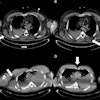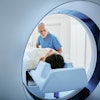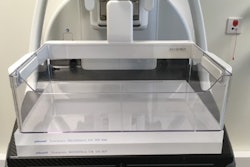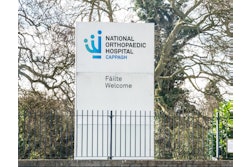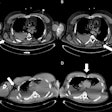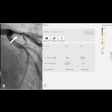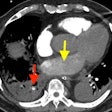Findings from a survey administered through the EuroSafe Imaging campaign show how diagnostic reference levels (DRLs) are being used at a local level, and where room for improvement remains.
An online survey consisting of 34 multiple-choice and open-field questions garnered a total of 146 responses from radiology departments in 38 countries, with 105 (71.9%) originating from European Union (EU) or European Economic Area (EEA) countries. The results were published in Insights into Imaging on 18 July.
Most respondents were radiologists (74%), with medical physicists and radiographers also responding, according to Prof. John Damilakis, PhD, chair of medical physics at the University of Crete, and colleagues. Nearly 70% of the sample said they worked at public institutions, with 37% reporting being employed at large institutions (over 800 beds). Additionally, 38.4% of respondents reported having over 20 years of experience.
More than half of respondents reported having locally established DRLs (52.4%); 34.5% reported a lack of local DRLs, while 13.1% were unaware if there were DRLs. For specific modalities, 88.7% reported having DRLs for CT and 77.5% for conventional radiography; lower DRL implementation was reported for interventional radiology (36.6%).
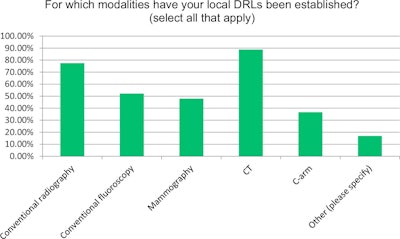 Distribution of imaging modalities with established local DRLs.
Distribution of imaging modalities with established local DRLs.
 Most common clinical indications for CT with established local DRLs.Figures courtesy of Prof. John Damilakis et al and Insights into Imaging.
Most common clinical indications for CT with established local DRLs.Figures courtesy of Prof. John Damilakis et al and Insights into Imaging.
Around 35% reported that they had high knowledge of DRLs, 34.9% had medium knowledge, and 22.6% had low knowledge, while 7.5% said that they were unaware of DRLs. DRLs were used routinely by 74.6%; smaller percentages of respondents reported occasional or rare (< 10%) use of DRLs. Over 37% of respondents said that local DRLs were used monthly, while 19.6% said they were used daily.
Over 80% said that they used dose management systems to implement their local DRLs. The authors cautioned that this reflects that the sample may not be representative of European institutions, as many hospitals in the EU have not implemented dose management systems. However, this finding also shows that dedicated tools may be used to support the implementation of DRLs.
While 67.9% said their main reason for using DRLs is dose optimization, which is a key goal of DRLs, 73.2% of respondents also said they use local DRLs to track outliers. In addition, 25% are motivated by regulatory compliance, while only 1.8% use DRLs for research purposes.
Over a third of respondents said they found DRLs to be very useful (34.7%), and another 44% said they are moderately useful in clinical practice. Respondents’ confidence in interpreting and applying local DRLs in their work showed similarly high percentages, with 33.7% being very confident and 39.8% moderately confident. However, a significant percentage, 26.5%, reported that they did not feel confident in applying the DRLs.
The lack of confidence in the use of DRLs in over a quarter of respondents highlights an area the survey shows is in need of improvement: lack of structured DRL education. Less than half (48.9%) of respondents said that their radiology residents receive education on DRLs; furthermore, 53.3% reported a lack of Continuing Professional Development (CPD) activities related to DRLs in their departments.
When asked what they perceived to be the main barriers or challenges related to using local DRLs, the respondents listed time constraints brought on by departmental workloads, data collection and data cleaning challenges, misunderstandings about the statistical basis of DRLs, standardization issues among protocols across different hospitals, and limited awareness of DRL significance.
The respondents suggested that the use of DRLs could be improved through such measures as greater staff involvement in data collection and calculation, more education and training on DRLs, conducting regular meetings to discuss DRL implementation and outcomes, establishing DRL workgroups, and allocating more resources to DRL-related activities.
Many of the suggestions for improvement emphasized greater structure: standardizing protocols and quality control in the use of equipment, rewarding compliance and penalizing noncompliance, and applying DRLs to areas such as radiotherapy imaging.
Overall, the authors concluded, while the responses show the value of local DRLs in clinical use, they also underscore the need for greater collaboration, training, and standardized protocols to improve their implementation.
Read the full article here.

